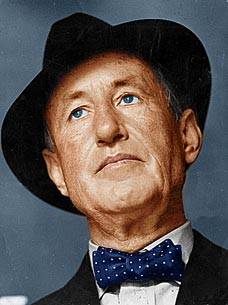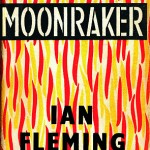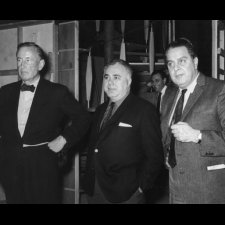
Roger Moore’s fourth James Bond movie Moonraker (1979), the eleventh in the smash-hit EON series, generated huge financial returns at the global box office, but it was very different to Ian Fleming’s original third novel (1955). In fact, apart from the main villain Sir Hugo Drax, very little was retained from the Bond creator’s largely UK-based plotline. Instead, the decision was taken to try and tap into the tremendous success of Star Wars and also the impending real-life launch of the new NASA space shuttle programme. Bond was taken into space, in a movie that pushed the hi-tech and sci-fi dimensions in Bond to new levels.
But did you know that a film version of Moonraker was envisaged back in the mid-1950s and, had it been successful, would have been the first big-screen 007 movie? Moreover, the screenplay could have been based on a treatment that was actually penned by Ian Fleming himself.
The story behind this ‘what if?’ question is familiar to Bond historians, but perhaps less so to general film fans and the wider public. Had it happened, of course, Bond’s career on screen may have been radically different.
The ‘lost script’
The UK’s Sunday newspaper The Observer recently revisited this fascinating episode in Fleming’s life under the heading ‘Ian Fleming, his lost script… and the Bond film the world never got to see’. To use the word ‘script’ is, of course, rather misleading – it was more a story outline, one that Fleming clearly hoped would have formed the basis of a full film script.

As the newspaper noted, in 1956, a year after his third 007 novel was published, Fleming wrote his own 150-page film treatment. It was in response to what he saw as the lethargy of the Rank film organisation, at the time probably Britain’s most important film production company. Rank had purchased the film rights to Moonraker, much to Fleming’s satisfaction, but then had done nothing with the book. The organisation’s script department did not seem able to develop the project and Fleming, who became increasingly frustrated in his dealings with Rank, had decided to pen his own screenplay and send it to Rank
The treatment that the Bond author put together contains some significant changes: the head of the British Intelligence Service MI6 is not called ‘M’ and comes across as much more affable than the gruff former Admiral of the novels and early EON films. In addition, there is no Miss Moneypenny. Fleming also created a brand new character, named ‘Tosh’, a Cockney card sharp who is really a Metropolitan Police Special Branch officer working undercover.
Bond and beyond
Jon Gilbert, an expert on all things Fleming, told the Observer: ‘This is the very first screenplay written by Fleming imagining Bond for the big screen. It is his only attempt at a film script, so it’s hugely important. It is a very Bondian scenario – a megalomaniac who wants to see the downfall of Britain’. However, and foolishly in hindsight, the Rank organisation failed to see its potential, and Fleming’s typed screenplay, still in its Rank folder, apparently remained forgotten decades after the 007 author had submitted it.
The undeveloped screen treatment has now come to light as part of a major collection of Bond material that has been amassed by Peter Harrington and Adrian Harrington, who run two antiquarian bookshops in London, and who have been dealing in Fleming and Bond books and printed ephemera for a considerable number of years. Jon Gilbert is the resident Fleming expert at Adrian Harrington Rare Books. According to Gilbert, the Fleming treatment is ‘far too descriptive’, rather than concentrating on dialogue (as most full scripts would do), but it still ‘reads very well’.
The treatment had been forgotten about until it surfaced at a Bonhams auction in 2015, from where it was purchased by a private collector.
Andrew Lycett, author of the best-selling biography Ian Fleming: The Man Who Created James Bond (recently republished in a second edition), told the Observer: ‘Finding this screenplay is very exciting. Fleming was obsessed with getting his books filmed. He tried very hard to interest producers in the UK and US’. Sir Alexander Korda, the famous film producer, had raised Fleming’s hopes at one stage when he asked to see an advanced copy of the second Bond novel Live and Let Die and had praised it. Fleming appears to have hoped he could interest Korda in Moonraker, a novel which Fleming very much wrote as a potential film story. But it was not to be.
No Deals, Mr. Bond
While Fleming did manage to sell the film rights to Casino Royale to the producer Gregory Ratoff, other attempts to negotiate firm film deals fell through. In fact, Fleming appears to have had his fingers burnt a number of times in his dealings with the film world.

Ian Hunter, for example, an actor, became interested in buying a six-months’ option on the film rights to Moonraker, but this fell through. Similarly, Stanley Meyer, the producer of Dragnet at Warner Brothers, had expressed an interest in Live and Let Die and Moonraker. But Fleming felt not enough money was being offered. Moreover, John Payne, another actor, offered Fleming $1,000 for a 9-month option on Moonraker, plus a further $10,000 if it had gone into full production. But, again, this fell through.
The deal with Rank for Moonraker appears to have raised Fleming’s hopes that, at last, something substantial would happen, and Moonraker as a movie would become ‘Moneyraker’ (so to speak). But, again, Fleming was to be sadly disappointed, and seems to have lost interest in the film world for a while. Indeed, it was not until 1959 that Fleming felt able to deal with ‘Hollywood’ again, and this time in the shape of the persuasive Irish producer Kevin McClory. That year, after a weekend of brainstorming with McClory and his associates, the Bond author agreed to write a rough film outline based on the ideas they had developed. But the actual full script-writing for the proposed first 007 movie was placed by McClory in the very capable hands of Jack Whittingham, a very experienced screenwriter and arguably, at the time, one of the top ten screenwriters in Britain. Whittingham developed Fleming’s outline treatment into a workable script, which (eventually) became the basis for Thunderball. But that’s a whole other story…
The Moonraker film treatment penned by Ian Fleming for Rank has been known about by Fleming’s biographers for some time, but the fact that we now have more details on its contents adds another intriguing chapter to the Bond author’s very up-and-down dealings with the film world, a relationship that did not reap any clear dividends until he finally settled a deal with Albert R. Broccoli and Harry Saltzman (EON) in 1961. The rest, as they say, is cinema history.

